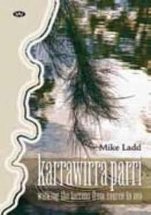Karrawirra Parri: walking the Torrens from source to sea by Mike Ladd

Photographs by Cathy Brooks. Wakefield Press, 2012. ISBN 978 1 74305
019 5.
(Ages: 12+) Recommended. Non Fiction. Environment. This handsomely
produced handbook of walking along the River Torrens from its Mount
Pleasant beginnings, through the hills and suburbs of Adelaide on to
its outlet at Henley Beach will beckon even the moot casual reader
to don their sneakers and take a stroll.
Each page builds an image in both words and pictures of a water
course moulded and changed by its surroundings as new settlements
were added with Adelaide growing beyond the first campsites of the
European settlers in 1836. Ladd strolls through early settlements,
marked now only by a hearth, or stone wall, following the water
course as it becomes a larger stream and then a river. Smetana's
Moldau kept coming to my mind as I walked with him, reading out loud
the snatches of verse by Wordsworth, Brooks and others, as well as
Ladd's haiku interspersing the engrossing commentary.
With only an outline map at the beginning of the book, showing the
river through the various Hills communities and suburbs, I needed to
grab a more detailed map which showed where access to these
beautiful spots was available. But this is a small quibble in
reading this absorbing travel book which gave some wonderful tidbits
of information. The history behind the name of Dernancourt, for
example, or the lists of introduced vegetation, native birds and
flowers, the story of the body in the Torrens in 1908.
With the upper reaches being in part through private land, his
meeting the Linear Park at Athelstone, meant an easier walk along
the areas begun in 1979 to preserve the banks of the river and its
wetlands, aiming for flood mitigation. The 35 kilometre stretch to
Henley Beach is a wonderful resource, and I can remember the angst
when it was first proposed.
First written as a series of article for The Adelaide Review,
Wakefield Press has published the complete set in what will
certainly delight the armchair traveller, and be a guide to those
who want to set out and stride it for themselves.
For students looking at the environment of Adelaide, then this is a
stunner as a wide perspective of the river is given, drawing in a
myriad of detail: the Aboriginal people both in the hills and on the
plains (Peramngk and Kaurna) the naming of the suburbs, the dams,
weirs and reservoirs, the flora and fauna, the poetry and small
details. I was surprised at how many times the black and red markers
were mentioned, and a catalogue of deaths along the river, or the
overgrown patches of introduced weeds and the kindness of strangers.
Not an academic tome, but a richly detailed story of one man's walk
through an area we all know about, but do not really know.
Fran Knight